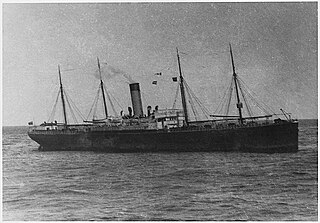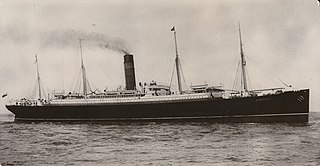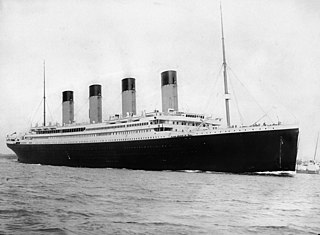
A Night to Remember is a 1955 non-fiction book by Walter Lord that depicts the sinking of the RMS Titanic on 15 April 1912. The book was hugely successful, and is still considered a definitive resource about the Titanic. Lord interviewed 63 survivors of the disaster as well as drawing on books, memoirs, and articles that they had written. In 1986, Lord authored his follow-up book, The Night Lives On, following renewed interest in the story after the wreck of the Titanic was discovered by Robert Ballard.

Cunard is a British shipping and cruise line based at Carnival House at Southampton, England, operated by Carnival UK and owned by Carnival Corporation & plc. Since 2011, Cunard and its three ships have been registered in Hamilton, Bermuda.

An ocean liner is a type of passenger ship primarily used for transportation across seas or oceans. Ocean liners may also carry cargo or mail, and may sometimes be used for other purposes. Only one ocean liner remains in service today.

SS Californian was a British Leyland Line steamship. She is thought to have been the only ship to see the Titanic, or at least her rockets, during the sinking, but despite being the closest ship in the area, the crew took no action to assist. The United States Senate inquiry and British Wreck Commissioner's inquiry into the sinking both concluded that the Californian could have saved many or all of the lives that were lost, had a prompt response been mounted to the Titanic's distress rockets. The U.S. Senate inquiry was particularly critical of the vessel's captain, Stanley Lord, calling his inaction during the disaster "reprehensible".

Edward John Smith was a British mercantile marine officer. He served as master of numerous White Star Line vessels. He was the captain of RMS Titanic, and perished when the ship sank on her maiden voyage.

The Battle of Yellow Tavern was fought on May 11, 1864, as part of the Overland Campaign of the American Civil War. Union cavalry under Maj. Gen. Philip Sheridan was detached from Grant’s Army of the Potomac to conduct a raid on Richmond, Virginia, and challenged Confederate cavalry commander Maj. Gen. J.E.B. Stuart. The Confederates were outnumbered, and Stuart was mortally wounded. However, Sheridan’s 'sideshow' did not achieve any of its other objectives, and had meanwhile deprived Grant’s army of key cavalry functions at Spotsylvania.

Sir Arthur Henry Rostron, KBE, RD, RNR was a British merchant seaman and a seagoing officer for the Cunard Line. He is best known as the captain of the ocean liner RMS Carpathia, when it rescued hundreds of survivors from the RMS Titanic after the ship sank in 1912 in the middle of the North Atlantic Ocean.
David Brown (1740–1812) was convicted of sedition because of his criticism of the United States federal government and received the harshest sentence for anyone under the Sedition Act of 1798 for erecting the Dedham Liberty Pole.
The 3rd Maryland Regiment was an infantry regiment of the Continental Army during the American Revolutionary War. It served from 1776 to 1783, mostly in the Middle Atlantic Region of the conflict.

Titanic sank in the early morning hours of 15 April 1912 in the North Atlantic Ocean, four days into her maiden voyage from Southampton to New York City. The largest ocean liner in service at the time, Titanic had an estimated 2,224 people on board when she struck an iceberg at around 23:40 on Sunday, 14 April 1912. Her sinking two hours and forty minutes later at 02:20 on Monday, 15 April, resulted in the deaths of more than 1,500 people, making it one of the deadliest peacetime maritime disasters in history.
A total of 2,208 people sailed on the maiden voyage of the Titanic, the second of the White Star Line's Olympic-class ocean liners, from Southampton, England, to New York City. Partway through the voyage, the ship struck an iceberg and sank in the early morning of 15 April 1912, resulting in the deaths of 1,503 people.

RMS Carpathia was a Cunard Line transatlantic passenger steamship built by Swan Hunter & Wigham Richardson in their shipyard in Wallsend, England.

Henry Eugene Davies was an American soldier, writer, public official and lawyer. He served in the Union Army as a brigadier general of volunteers in cavalry service during the American Civil War and was promoted to the grade of major general of volunteers at the end of the war. Davies was one of the few nonprofessional soldiers in the Union cavalry in the East to be promoted to the grade of general. He led his brigade in several major battles, especially during the Overland Campaign, the Battle of Trevilian Station, the Siege of Petersburg and the Appomattox Campaign at the end of the war.

This is a timeline of the world's largest passenger ships based upon internal volume, initially measured by gross register tonnage and later by gross tonnage. This timeline reflects the largest extant passenger ship in the world at any given time. If a given ship was superseded by another, scrapped, or lost at sea, it is then succeeded. Some records for tonnage outlived the ships that set them - notably the SS Great Eastern, and RMS Queen Elizabeth. The term "largest passenger ship" has gradually fallen out of use since the mid-1990s. Since that time the title of "largest cruise ship" has largely been given to those confined to cruising rather than transatlantic ocean travel.

HMS Pomona was a 28-gun Enterprise-class sixth-rate frigate of the Royal Navy. Pomona was first commissioned in September 1778 under the command of Captain William Waldegrave.

Titanic Lifeboat No. 1 was a lifeboat from the steamship RMS Titanic. It was the fifth boat launched to sea, over an hour after the liner collided with an iceberg and began sinking on 14 April 1912. With a capacity of 40 people, it was launched with only 12 aboard, the fewest to escape in any one boat that night.

Lifeboats played a crucial role in the sinking of the Titanic on 14–15 April 1912. The ship had 20 lifeboats that, in total, could accommodate 1,178 people, a little over half of the 2,209 on board the night it sank.

The sinking of the RMS Titanic on April 14–15, 1912 resulted in an inquiry by a subcommittee of the Commerce Committee of the United States Senate, chaired by Senator William Alden Smith. The hearings began in New York on April 19, 1912, later moving to Washington, D.C., concluding on May 25, 1912 with a return visit to New York.
The ocean liner RMS Titanic has been extensively portrayed in films, books, memorials and museums.














